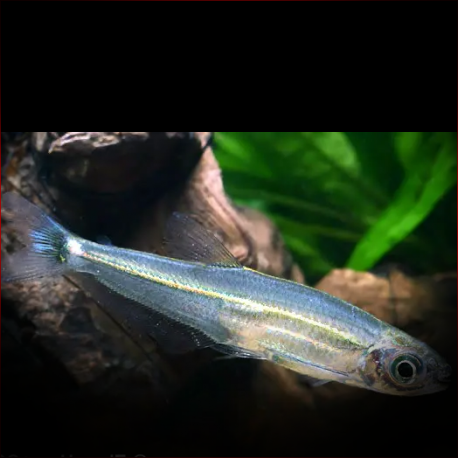More info
Datasheet
| Minimum Tank Size | 240 litres / 63.40 US gallons |
| Maximum Size | 10.2cm / 4.02inches |
| Temperature | 20°C / 68.00°F - 28°C / 82.40°F |
| Hardness | 1.01dgH / 18ppm - 12.05dgH / 215ppm |
| pH | 5.0-7.5 |
General Description
The Green Line Lizard Tetra, scientifically known as Iguanodectes Spilurus, is a peaceful fish commonly found in community aquariums. It is distinguishable by its translucent dorsal and anal fins, absence of a red lateral stripe, and a distinct dark caudal fin marking. Belonging to the Characiformes order, this tetra species is part of the Iguanodectidae family, characterized by elongated bodies and specific dental and fin features.
Aquarium Setup
For optimal care, the Green Line Lizard Tetra thrives in a minimum tank size of 240 liters with a sandy substrate, driftwood roots, and branches. This species appreciates a planted environment but is sensitive to poor water conditions. Maintaining water hardness between 18-215ppm, a pH level of 5.0-7.5, and a temperature range of 20-28°C creates an ideal habitat. However, detailed tank setup guidelines are available in the provided table.
Behaviour
The Green Line Lizard Tetra displays peaceful behavior, making it an excellent addition to community aquariums. To ensure harmonious cohabitation, it is recommended to keep them with similarly-sized fish like characids, gasteropelecids, and non-predatory cichlids. Male tetras display vibrant colors when competing for female attention or establishing hierarchical positions within the group. Maintaining a mixed-sex group with more females can help reduce excessive male harassment.
Feeding and Diet
Being omnivorous, the Green Line Lizard Tetra's diet in the wild consists of small invertebrates, crustaceans, algae, and fallen fruits. In captivity, they can survive on dried foods but show optimal health when offered a diverse menu including live and frozen options like bloodworms, mosquito larvae, Daphnia, and Moina. A varied diet contributes to the overall well-being of the tetras.
Reproduction & Dimorphism
During the breeding season, nuptial males of the Green Line Lizard Tetra develop hooks and lappets on their anterior anal fin rays. To encourage successful reproduction, providing ample hiding spots for spawning is recommended. The species often breed in a community setting, and observing their reproductive behavior can be fascinating for aquarists.
Habitat and Distribution
Found in various river systems across Brazil, Peru, Bolivia, Venezuela, and other South American countries, the Green Line Lizard Tetra prefers minor tributaries, small rivers, oxbows, and flooded forests. Inhabitants of clear water habitats with sandy substrates, they coexist with numerous other fish species in areas rich in aquatic plants and riparian vegetation. Detailed distribution information is available in the provided description.

